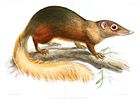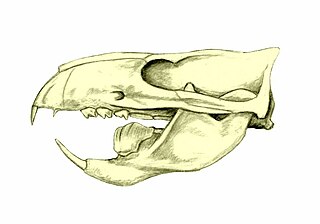
Ptilodus is a genus of mammals from the extinct order of Multituberculata, and lived during the Paleocene in North America.
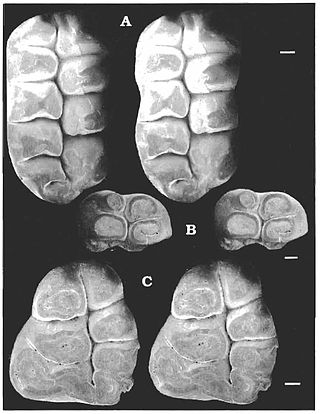
Catopsalis is a genus of extinct mammal from the Paleocene of North America. This animal was a relatively large member of the extinct order of Multituberculata. Most multituberculates were much smaller.
Parectypodus is an extinct genus of mammals that lived from Late Cretaceous (Maastrichtian) to Eocene time in North America. It is a member of the extinct order of Multituberculata, suborder Cimolodonta, family Neoplagiaulacidae. It was named by G.L. Jepsen in 1930.
Baiotomeus is a genus of mammals from the extinct order of Multituberculata. It is known from the Paleocene of North America.
Eucosmodon is a genus of extinct mammal from the Paleocene of North America. It is a member of the extinct order of Multituberculata within the suborder of Cimolodonta, and the family Eucosmodontidae. This genus has partly also been known as Neoplagiaulax. All known fossils of this small mammal are restricted to teeth.
Stygimys is an extinct mammal genus from the Upper Cretaceous and Paleocene of North America. It was a member of the extinct order Multituberculata within the suborder Cimolodonta, family Eucosmodontidae.
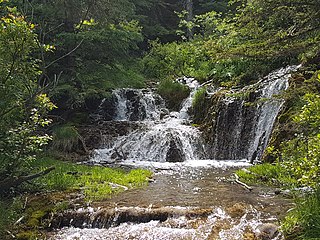
Big Hill Springs Provincial Park is a provincial park in the foothills of Alberta's Rocky Mountains, about 40 kilometres (20 mi) northwest of Calgary, Alberta, Canada. It features a series of springs and small waterfalls that flow year-round over rocky terraces covered with a lush growth of mosses, shrubs, and grasses. The park also includes the ruins of a historic fish hatchery and Alberta's first commercial creamery. The main activities at the park are hiking, picnicking, scenic viewing, wildlife watching, and photography.

The Scollard Formation is an Upper Cretaceous to lower Palaeocene stratigraphic unit of the Western Canada Sedimentary Basin in southwestern Alberta. Its deposition spanned the time interval from latest Cretaceous to early Paleocene, and it includes sediments that were deposited before, during, and after the Cretaceous-Paleogene (K-Pg) extinction event. It is significant for its fossil record, and it includes the economically important coal deposits of the Ardley coal zone.

The Paskapoo Formation is a stratigraphic unit of Middle to Late Paleocene age in the Western Canada Sedimentary Basin. The Paskapoo underlies much of southwestern Alberta, and takes the name from the Blindman River. It was first described from outcrops along that river, near its confluence with the Red Deer River north of the city of Red Deer, by Joseph Tyrrell in 1887. It is important for its freshwater aquifers, its coal resources, and its fossil record, as well as having been the source of sandstone for the construction of fire-resistant buildings in Calgary during the early 1900s.
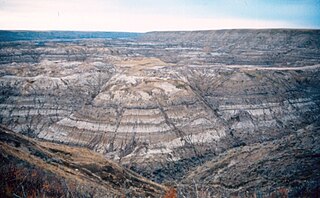
Within the earth science of geology, the Edmonton Group is a Late Cretaceous to early Paleocene stratigraphic unit of the Western Canada Sedimentary Basin in the central Alberta plains. It was first described as the Edmonton Formation by Joseph Burr Tyrrell in 1887 based on outcrops along the North Saskatchewan River in and near the city of Edmonton. E.J.W. Irish later elevated the formation to group status and it was subdivided into four separate formations. In ascending order, they are the Horseshoe Canyon, Whitemud, Battle and Scollard Formations. The Cretaceous-Paleogene boundary occurs within the Scollard Formation, based on dinosaurian and microfloral evidence, as well as the presence of the terminal Cretaceous iridium anomaly.
The Ravenscrag Formation is a stratigraphic unit of early Paleocene age in the Western Canada Sedimentary Basin. It was named for the settlement of Ravenscrag, Saskatchewan, and was first described from outcrops at Ravenscrag Butte near the Frenchman River by N.B. Davis in 1918.
The Porcupine Hills Formation is a stratigraphic unit of middle to late Paleocene age in the Western Canada Sedimentary Basin. It takes its name from the Porcupine Hills of southwestern Alberta, and was first described in outcrop by George Mercer Dawson in 1883.
Edworthia is an extinct genus of paromomyid plesiadapiform which existed in Alberta, Canada, during the early Paleocene. It was first named by Richard C. Fox, Craig S. Scott and Brian D. Rankin in 2010 and the type species is Edworthia lerbekmoi. Edworthia described from a recently discovered locality in the Paskapoo Formation, exposed at a road cut in Edworthy Municipal Park.
The Paskapoo Slopes are a significant natural, environmental and cultural feature on the western side of Calgary, Alberta. They have a high visual impact and are a prominent landmark along the Trans Canada Highway, Calgary's western gateway from the Rockies.
Metasequoia foxii is an extinct redwood species in the family Cupressaceae described from numerous fossils of varying growth stage. The species is solely known from the Paleocene sediments exposed in central Alberta, Canada. It is one of three extinct species belonging to the redwood genus Metasequoia.
The Coalspur Formation is an Upper Cretaceous to lower Palaeocene stratigraphic unit of the Western Canada Sedimentary Basin in the foothills of southwestern Alberta. Its deposition spanned the time interval from latest Cretaceous (Maastrichtian) to early Palaeocene, and it includes sediments that were deposited before, during, and after the Cretaceous-Paleogene (K-Pg) extinction event. It includes the economically important coal deposits of the Coalspur Coal Zone, as well as nonmarine plant and animal fossils.

Coniophis is an extinct genus of snakes from the late Cretaceous period. The type species, Coniophis precedes, was about 7 cm long and had snake-like teeth and body form, with a skull and a largely lizard-like bone structure. It probably ate small vertebrates. The fossil remains of Coniophis were first discovered at the end of the 19th century in the Lance Formation of the US state of Wyoming, and were described in 1892 by Othniel Charles Marsh. For the genus Coniophis, a number of other species have been described. Their affiliation is, however, poorly secured, mostly based on vertebrae descriptions from only a few fossils.
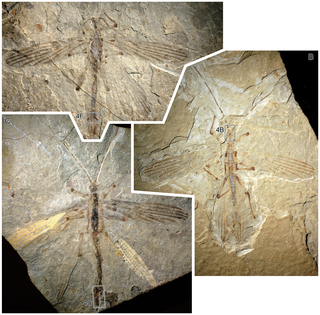
Susumanioidea is an extinct superfamily of Phasmatodea, known from the Middle Jurassic to Eocene. They lie outside the modern crown group of Phasmatodea. Members of the group typically possess large, fully developed wings.
Saxonella is a genus of extinct primate from the Paleocene Epoch, 66–56 Ma. The genus is present in the fossil record from around ~62–57 Ma. Saxonella has been found in fissure fillings in Walbeck, Germany as well as in the Paskapoo Formation in Alberta, Canada. Saxonella is one of five families within the superfamily Plesiadapoidae, which appears in the fossil record from the mid Paleocene to the early Eocene. Analyses of molars by paleontologists suggest that Saxonella most likely had a folivorous diet.
Anguispira russelli was a species of pulmonate land snail in the family Discidae, the disk snails. The species is only known from fossilized specimens. It is named after L.S. Russell, former Director of Zoology at the National Museum of Canada.









